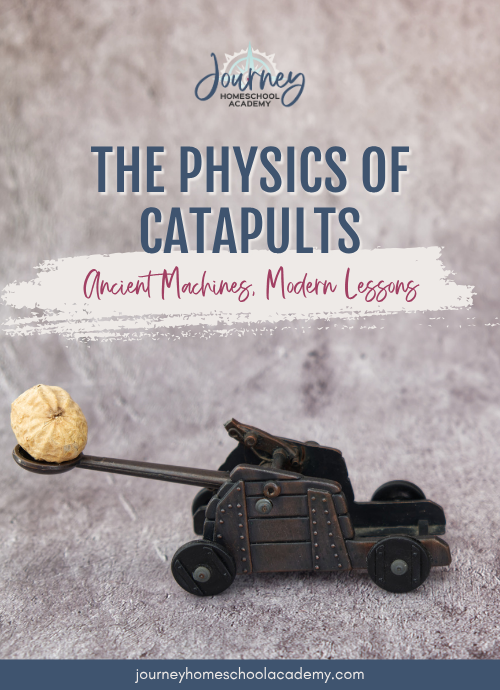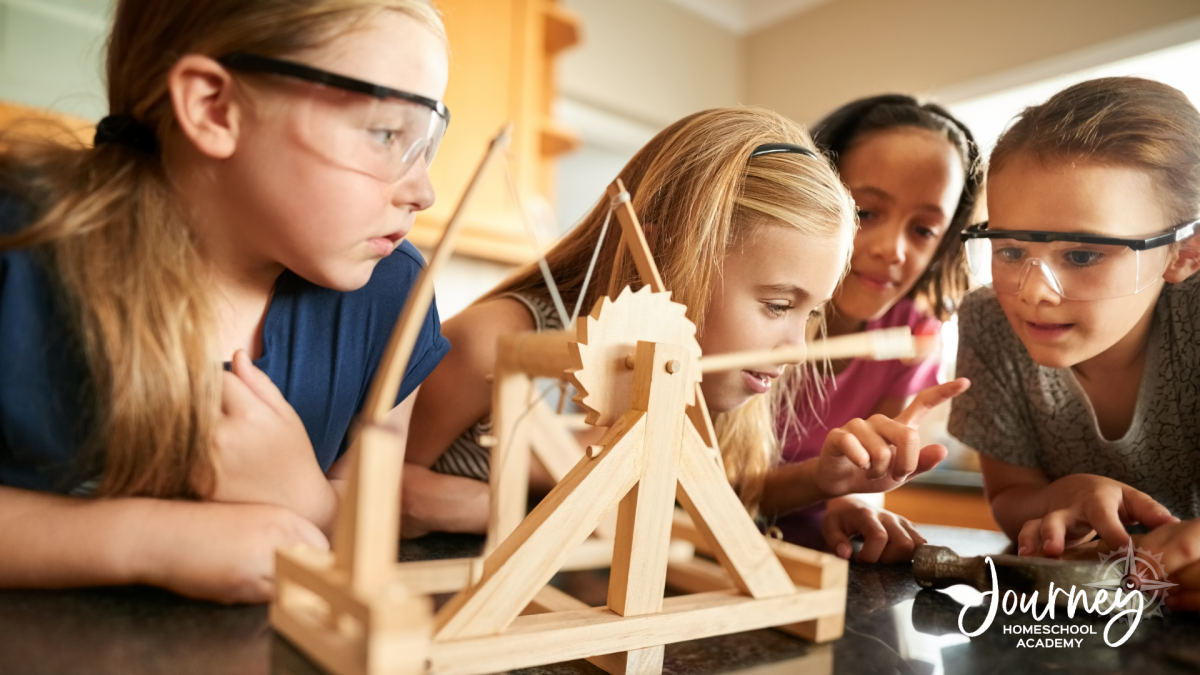If your kids ever played Angry Birds, they’ve already had a fun (and slightly addictive) introduction to basic physics. While the game mostly uses a slingshot instead of a catapult, the underlying principles are the same — tension, force, and trajectory working together to launch an object through the air.
For many of our kids, that might have been their first exposure to how physics really works, even if they didn’t realize it at the time. Now that those same kids are teens, that early curiosity can turn into a real understanding of motion and energy through hands-on projects like building a catapult.
That’s one of the reasons I love JHA’s Discover Physics. It helps take the fun and fascination of “how things move” and turn it into confident, practical learning in our homeschool.
So whether you are a long-time homeschooler or just starting your journey, grab your rubber bands, popsicle sticks, and imagination. Let’s explore how an ancient invention can teach our children the timeless laws of physics.
The Physics of Catapults: Ancient Machines, Modern Lessons

From Siege Machines to Science Experiments
Catapults have fascinated people for more than 2,000 years. The Greeks, Romans, and medieval engineers used them to launch stones and other projectiles during warfare. The word catapult comes from the Greek katapultos, which means “to hurl against.” It was quite a literal description of what these powerful machines did.
These ancient builders were physicists before the term existed. They understood how to store potential energy through twisted ropes or heavy counterweights and then release it as motion. They may not have had modern math, but they had plenty of observation, experimentation, and creativity.
If you want a short, reliable background on the history of catapults, check out the Encyclopaedia Britannica article on catapults. It’s a great primer for older students who like connecting science and history.
When we build small catapults at home, we are retracing those same discoveries on a smaller, safer, and much cleaner scale.

The Science Behind the Sling
Every time your child launches a pom-pom or marshmallow across the room, they are practicing physics in motion. Here are a few key principles that catapult experiments reveal:
1. Potential and Kinetic Energy
A catapult stores energy in tension or weight, which is released to move an object. The stored energy (potential) becomes motion (kinetic). This transfer is what powers everything from rubber bands to rocket boosters.
2. Newton’s Laws in Action
Each launch demonstrates Newton’s three laws of motion. The heavier the object, the more force it needs to accelerate. A student can see that doubling the pull on a rubber band sends the projectile twice as far. It is science that feels like play.
3. Projectile Motion and Angles
Launch angle matters. The same force applied at a different angle changes the distance and height of the flight. Around 45 degrees is usually the sweet spot for maximum range. If your students want to understand the math behind it, NASA’s LaunchPad Learning Resource explains it clearly.
💡Homeschool tip: Have students predict the range before each launch, then measure and record results. It turns a fun experiment into a simple physics lab.

Build It Yourself: A Hands-On Homeschool Physics Lesson
You do not need an engineering degree or fancy equipment to make a catapult. In fact, simple designs are often the most effective. Our family favorite uses popsicle sticks, rubber bands, and a plastic spoon. It takes only a few minutes to assemble and is a great activity for a rainy afternoon.
For clear, step-by-step instructions, try Science Buddies’ Popsicle Stick Catapult Project. It’s easy to follow and adaptable for any age group.
Once your catapult is ready:
- Choose light projectiles such as pom-poms or mini marshmallows.
- Mark a safe launch zone.
- Test different angles and tensions.
- Record how far each object travels.
- Change one variable at a time and observe how it affects distance.
You can take it further by graphing results, calculating speed, or estimating force. Without realizing it, your kids are practicing the scientific method and critical thinking.
You can also check this downloadable article from North East Museum where there’s another version of the DIY catapult.

From Backyard Launches to Real Learning
When students see their own catapults send projectiles flying, they are not just learning physics. They are building confidence, curiosity, and a love for discovery.
This is exactly the philosophy behind Discover Physics. Journey Homeschool Academy’s course doesn’t just lecture about motion or gravity. It engages students through visuals, experiments, and stories that make the material memorable. My own teenager has gone from dreading science to looking forward to the next experiment.
If you are part of a homeschool co-op, a catapult challenge can make a fantastic group project. Students can collaborate, share designs, and test whose model launches the farthest.
Learn more about how to bring these projects to your group through JHA’s Co-Op Program.

Catapults and Modern Physics: Same Principles, Bigger Scale
The physics that makes a backyard catapult work also powers some of the world’s most advanced technology. The same forces that flung stones across ancient battlefields now launch airplanes off aircraft carriers. Modern catapult systems rely on hydraulics and magnetism, but the underlying science is identical.
NASA engineers even use catapult principles in modern design and testing. You can explore how they apply these concepts in this video. The link between ancient invention and modern innovation is a powerful reminder that science builds on curiosity that never stops asking “why.”

Launch Your Homeschool Physics Journey
If the thought of teaching high school physics feels intimidating, you are not alone. Many parents feel the same way. But with the right resources, it does not have to be stressful. Discover Physics does the heavy lifting for you through:
- Engaging video lessons
- Hands-on labs and experiments
- Built-in quizzes and grading
- Step-by-step parent support
Your role is not to be the expert but to guide your students toward experts who can inspire them. That is what makes Journey Homeschool Academy such a valuable partner for families who want rigorous academics presented from a Christian worldview.
So go ahead, grab a few supplies and start launching. One small catapult project might just ignite a lifelong interest in science.

